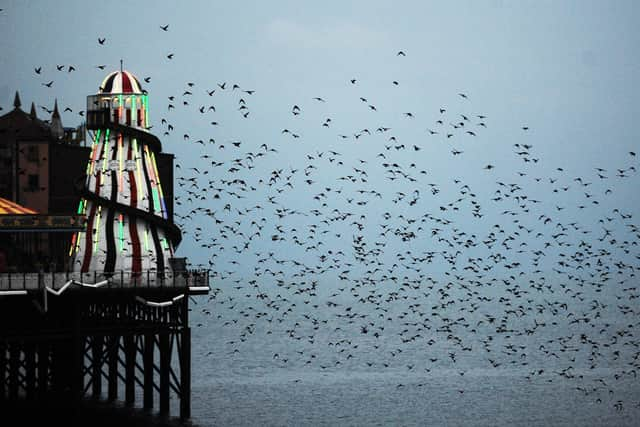Video captures spectacular starling murmuration in Pulborough
and live on Freeview channel 276
Mike, who believes the starlings were being pursued by a peregrine falcon – or perhaps two – took the footage in Pulborough.
But amazing as these displays are, they are not as common as they perhaps once were.


Advertisement
Hide AdAdvertisement
Hide AdLou McCurdy, who recently penned a column in the West Sussex Gazette as part of a series of articles in partnership with the Knepp Wildland Foundation (see ‘Read more’ link above), is a Brighton-based environmental artist who recently told the story of her city’s starlings in an exhibition.
She said: “As spectacular as these multitudes seem, though, starlings are in trouble. Between 1970-2018 the UK’s breeding population crashed 82 per cent.
“Habitat loss in rural areas, and lack of seeds and insects to eat – the result of intensive agriculture, pollutants and pesticides – are considered the cause.
Advertisement
Hide AdAdvertisement
Hide Ad“Starlings are now on the red list as a bird for high conservation concern, declining at a rate of 150 birds an hour since the 1980s.”
Lou also explored the reason for the murmurations.
She said: “The more we learn about these creatures, the more wonderful they seem.
“Why do starlings murmurate? There is strength in numbers. By gathering, flying and roosting together starlings protect each other both from predators and the cold. But they also seem to murmurate for fun, for the sheer joy of flying together as a flock.
Advertisement
Hide AdAdvertisement
Hide Ad“Starlings are particularly gregarious and communicative. Our UK birds welcome migratory starlings from Europe seamlessly into their murmurations every year.
“Starlings have binocular vision and can see colours invisible to the human eye. They have an incredible vocal range of pops, cackles, chuckles and whistles and are masterful mimics, impersonating anything from car alarms to a hawk’s cry.
“They have magnetite crystals in their beaks, and magnetite perception in the right eye that can detect the magnetic field in order to navigate at night.
“Faced with collapsing resources in the countryside starlings are finding sustenance, now, in the urban environment.
“They feast on the seeds of shrubs in gardens, parks and allotments, probe for juicy leather-jacket larvae beneath our lawns, and catch other invertebrates in urban wild patches.”
